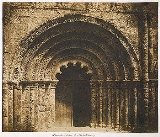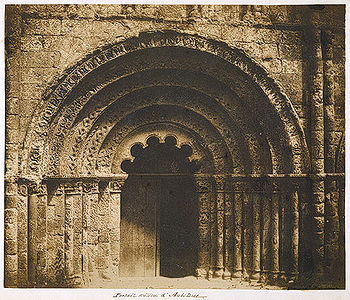
Missions Héliographiques
Encyclopedia
Prosper Mérimée
established the Missions Héliographiques in 1851 to supplement Monument historique
a program he had established in 1837 to classify, protect and restore French
landmarks. Mérimée, noted author of Carmen
, served as France's Inspector General of Historical Monuments, and he hired Edouard Baldus
, Hippolyte Bayard
, Gustave Le Gray
, Henri Le Secq
and O. Mestral. These five photographers photographed various landmarks and monuments around France so that the architect Eugène Viollet-le-Duc
could eventually restore them.
Although the daguerrotype originated in France
, Mérimée preferred the calotype
, which offered more detailed textures.
 While Mestral and Le Gray went southwest from Paris
While Mestral and Le Gray went southwest from Paris
, Le Secq’s itinerary sent him north and east. Bayard, who burdened himself by choosing to work with glass negatives instead of paper, went west, to Brittany
and Normandy
. Finally, Baldus spent time in the south and east, where he photographed the Palace of Fontainebleau and other landmarks.
While several of the photographs remain classic examples of early photography, the results were mediocre at best. Ironically, the photographers’ artistry helped doom the project: Exquisite photos of the decaying buildings portrayed them in a positive manner that did nothing to show the need for restoration.
Prosper Mérimée
Prosper Mérimée was a French dramatist, historian, archaeologist, and short story writer. He is perhaps best known for his novella Carmen, which became the basis of Bizet's opera Carmen.-Life:...
established the Missions Héliographiques in 1851 to supplement Monument historique
Monument historique
A monument historique is a National Heritage Site of France. It also refers to a state procedure in France by which national heritage protection is extended to a building or a specific part of a building, a collection of buildings, or gardens, bridges, and other structures, because of their...
a program he had established in 1837 to classify, protect and restore French
France
The French Republic , The French Republic , The French Republic , (commonly known as France , is a unitary semi-presidential republic in Western Europe with several overseas territories and islands located on other continents and in the Indian, Pacific, and Atlantic oceans. Metropolitan France...
landmarks. Mérimée, noted author of Carmen
Carmen (novella)
"Carmen" is a novella by Prosper Mérimée, written and first published in 1845. It has been adapted into a number of dramatic works, including the famous opera by Georges Bizet.-Sources:...
, served as France's Inspector General of Historical Monuments, and he hired Edouard Baldus
Edouard Baldus
Édouard-Denis Baldus was a French landscape, architectural and railway photographer.Baldus was originally trained as a painter and had also worked as a draughtsman and lithographer before switching to photography in 1849...
, Hippolyte Bayard
Hippolyte Bayard
-Late career:Despite his initial hardships in photography, Bayard continued to be a productive member of the photographic society. He was a founding member of the French Society of Photography...
, Gustave Le Gray
Gustave Le Gray
Jean-Baptiste Gustave Le Gray has been called "the most important French photographer of the nineteenth century" because of his technical innovations in the still new medium of photography, his role as the teacher of other noted photographers, and the extraordinary imagination he brought to picture...
, Henri Le Secq
Henri Le Secq
Henri Jean-Louis Le Secq was a French painter and photographer. After the French government made the daguerreotype open for public in 1851, Le Secq was one of the five photographers selected to carry out a photographic survey of architecture .-Early life:Henri Le Secq was born in 1818 in Paris and...
and O. Mestral. These five photographers photographed various landmarks and monuments around France so that the architect Eugène Viollet-le-Duc
Eugène Viollet-le-Duc
Eugène Emmanuel Viollet-le-Duc was a French architect and theorist, famous for his interpretive "restorations" of medieval buildings. Born in Paris, he was a major Gothic Revival architect.-Early years:...
could eventually restore them.
Although the daguerrotype originated in France
France
The French Republic , The French Republic , The French Republic , (commonly known as France , is a unitary semi-presidential republic in Western Europe with several overseas territories and islands located on other continents and in the Indian, Pacific, and Atlantic oceans. Metropolitan France...
, Mérimée preferred the calotype
Calotype
Calotype or talbotype is an early photographic process introduced in 1841 by William Henry Fox Talbot, using paper coated with silver iodide. The term calotype comes from the Greek for 'beautiful', and for 'impression'....
, which offered more detailed textures.

Paris
Paris is the capital and largest city in France, situated on the river Seine, in northern France, at the heart of the Île-de-France region...
, Le Secq’s itinerary sent him north and east. Bayard, who burdened himself by choosing to work with glass negatives instead of paper, went west, to Brittany
Brittany
Brittany is a cultural and administrative region in the north-west of France. Previously a kingdom and then a duchy, Brittany was united to the Kingdom of France in 1532 as a province. Brittany has also been referred to as Less, Lesser or Little Britain...
and Normandy
Normandy
Normandy is a geographical region corresponding to the former Duchy of Normandy. It is in France.The continental territory covers 30,627 km² and forms the preponderant part of Normandy and roughly 5% of the territory of France. It is divided for administrative purposes into two régions:...
. Finally, Baldus spent time in the south and east, where he photographed the Palace of Fontainebleau and other landmarks.
While several of the photographs remain classic examples of early photography, the results were mediocre at best. Ironically, the photographers’ artistry helped doom the project: Exquisite photos of the decaying buildings portrayed them in a positive manner that did nothing to show the need for restoration.

